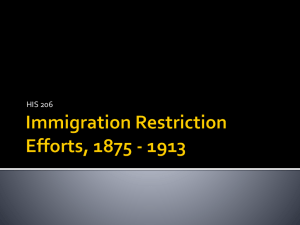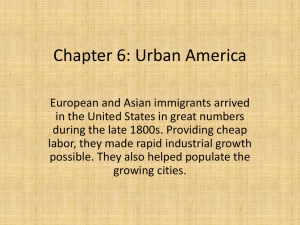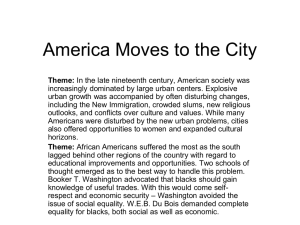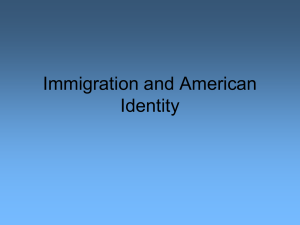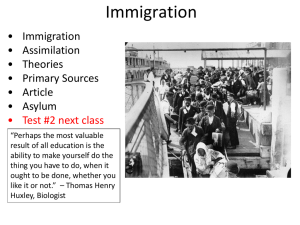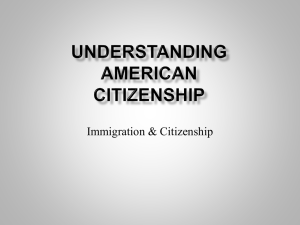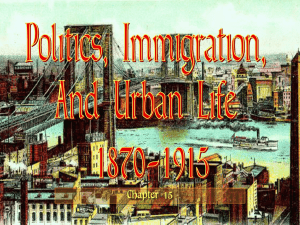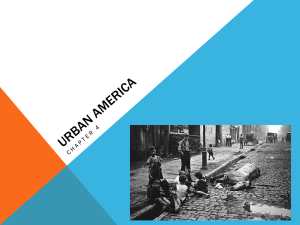Immigration
advertisement
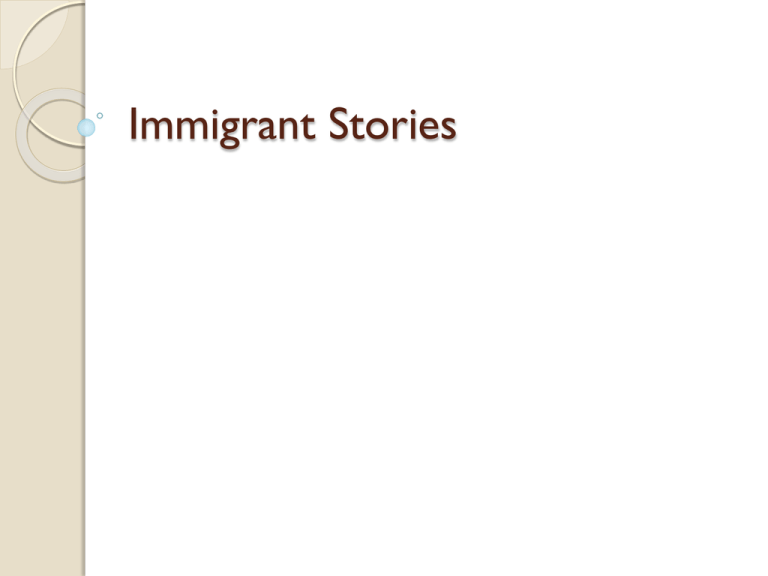
Immigrant Stories Bell Work: Should immigrants to the US change their language, religion, and customs once they move here (assimilate) or not? ◦ Why should they assimilate or not assimilate? Salad Bowl v. Melting Pot Immigration Stats Since 1820 ◦ 65 Million immigrants have entered US ◦ 40% of that total entered from 1881-1920 Immigration after 1920 Immigration from 1881-1920 Why they came Push factors ◦ Poor economy ◦ Potato blight Northwestern Europe ◦ Discrimination and ethnic cleansing Pull factors ◦ US is expanding Need for factory, railroad workers Land is available (Homestead Act 1862) Steamship lines advertise US as ‘land of opportunity’ Directions Alone or with a partner choose one story ◦ Read it ◦ Create a Haiku or Limerick that describes this story 15 minutes - Prepare to share Limerick (lines 1,2,5 and then 3,4 rhyme) There once was a man from Peru Who dreamt he was eating his shoe He awake in the night With a terrible fright Haiku (syllables 5-7-5) I walk across sand And find myself blistering In the hot, hot heat Chinese Exclusion Act 1882 BELL WORK: Analyze this cartoon using LIE A brief history of immigration “Why should the nation become a Colony of aliens, who will shortly be so numerous … and will never adopt our language or customs, any more than they can acquire our complexion?” Why did we pass the Chinese Exclusion Act? DIRECTIONS 1. Examine the timeline What happened between the 1860s, when Chinese were welcomed, and 1882, when they were excluded? 2. Using Documents A-D Complete the Graphic Organizer 1. Combine the information from the timeline and primary sources Answer the final question (1 paragraph) Immigration 1924 National Origins Act Directions Please take out your “Chinese Exclusion Act” Packet ◦ Make sure you have completed steps 1-3 You may work with your partner from yesterday (5 mins) ◦ We will discuss this and then hand it in for credit Today’s Agenda - Discuss and Hand in Act Packet - Dillingham Commission Report - 1924 National Origins Act Bell Work Please analyze using LIE Anti - Immigration 1. 2. 3. 4. 5. Pro - Immigration New immigrants won’t assimilate They are drunks, unwashed, uncultured They bring poverty, disease, and threaten American culture They provide cheaper labor than US citizens Immigrant voters can be manipulated 1. 2. 3. 4. 5. Immigrants bring skills to America that benefit the nation Diversity is a positive thing This nation was created by immigrants seeking a better life, that tradition should continue Unskilled immigrants work more cheaply and take the jobs that US citizens don’t want helping bring down the cost of goods If you try to block people from coming here legally, they will just come illegally. Opinions Immigrants react to negative attitudes. Form close-knit communities ◦ “Little Italy” ◦ “Chinatown” Keeps culture alive Keeps them safe Keeps them isolated Makes things worse? How does the US deal with immigration in the early 1900s? Dillingham Commission 1907-1911 ◦ 4 Principles 1. We welcomed them in the past BUT there are too many people coming here and the quality of immigrant has decreased making it much more difficult for them to assimilate 2. The physically and mentally unfit should not be allowed into the country for economic reasons 3. The number of immigrants allowed into the country should correspond to the number of available jobs 4. If there are too many new immigrants they lower the standard of living since they are willing to work for low wages How does the US deal with immigration in the early 1900s? Dillingham Commission 1907-1911 ◦ 3 Restrictions 1. Set limits on how many immigrants can enter the country per year 2. If they do not intend to become citizens or live here permanently they should not be allowed. Especially men with no wives or children. 3. Do not allow those who (because of their personal qualities or habits), would be least likely to assimilate and would make the least desirable citizens. How does the US deal with immigration in the early 1900s? Dillingham Commission 1907-1911 ◦ 4 Methods 1. Do not allow anyone who cannot read or write in some language 2. Limit the number of people allowed in based on their race 3. Increase the fees to enter the country 4. Charge more for single men then for men with a wife and children National Origins Act - 1924 Based on the Dillingham Commission Report ◦ Limited the number of immigrants from each country Europeans = 2% of the number of European Immigrants in the US in 1890 Italians, Hungarians, Poles were hardly here at all before 1890 – access greatly reduced Further closes the door to people from Asia National Origins Act Cont… Effect ◦ Immigration falls to its lowest point since the mid1800s 1930s ◦ The National Origins Act ◦ Great Depression ◦ World War II Combine to almost completely stop immigration In the 1930s the number of people LEAVING the US is greater than the number of people moving in. Illegal Immigration Today Bell Work: please answer the question below in your notebook… How do the fears and solutions regarding immigrants from 1880-1924 compare to the fears and solutions you have heard people discuss today? 1. ◦ ◦ ◦ How are they similar/different? Were fears then real or imagined? Are today’s fears real or imagined? Today’s Immigration Opinions Pro Immigration High-tech industries depend on them ◦ 12% of immigrants earn college degrees (8 % of native born Americans) ◦ 30% of tech startups in 1990s Anti Immigration Concerned that high levels of immigrants take away jobs from native-born Americans 1/3 of of immigrants lack a high school diploma Keep cities strong ◦ Start small businesses - Create new jobs ◦ Largest US cities would have seen a drop in population since 1980 without immigration Diversity is a positive thing Their work helps bring down the cost of goods and they will take jobs native-born citizens won’t take ◦ Double the amount of native born Americans Drains poor countries of their most talented citizens We are currently in a recession there is a job shortage Today’s Immigration Policy Emphasis on reuniting families and attracting skilled workers Only 20,000 immigrants allowed per country (same for every nation) Yearly cap of immigrants is 290,000 Birth Born here 1. ◦ Congrats! You’re in Born in another country? 2. ◦ As long as one of your parents is a US citizen you’re in! Naturalization 1. At least 18 2. Have applied for and been lawfully admitted to the US for permanent residence 3. Live here for 5+ years with Green Card 4. Show good moral character 5. Pass English Language test 6. Pass a US ‘knowledge’ test 7. Take an oath of Allegiance to the US How to become a citizen in 2012 2 Ways What if you came here illegally? If you want to become a Citizen: ◦ you must go back to your country of origin and apply for admittance ◦ May take years or may never happen 2005 -The Dream Act -Allow people brought here illegally by their parents WHEN THEY WERE CHILDREN to apply for citizenship without deportation when they turn 18 - If they are enrolled in college - Or if they join the military DOES NOT BECOME A LAW 2012 – Some in government are calling for the Dream Act to be looked at again or a similar policy to be put in place. 30 Days – I’m an Illegal Immigrant Draw a T-Chart in your notebook. During the video please take notes on the 2 views presented in the video. View 1: The family should be allowed to stay View 2: The family should be deported Policy Paper Intro Bell Work Take out your T chart from yesterday ◦ We are starting the video right away. Discuss What should be done about people in this family’s situation? ◦ Should they be given an opportunity to become citizens without deportation? ◦ Should this only be an opportunity for the children and not the adults or should it cover everyone? Please be able to explain your answer Illegal Immigration Today In the last 3 years ◦ 1.2 million immigrants deported Majority Latinos Currently ◦ Estimated11.2 million illegal immigrants live in the US Illegal Immigration Cont… Concentrated in: ◦ California, Texas, New York, Florida, Illinois 1982 Supreme Court Ruling ◦ States must provide schooling for kids here illegally Increases budget for schools California = 2 billion/yr Many businesses employ in low paying and difficult jobs ◦ Los Angeles Garment Industry = most profit ◦ Who should be punished? Writing based on sources Recognize what the source is, its value and flaws ◦ Purpose, Audience, Bias ALWAYS ◦ Make it clear that the SOURCE is saying something, NOT that you are saying it “In reaction, propaganda such as the play (Doc. A) portrayed Chinese immigrants as selfish and conspiring to intentionally run the “white man” out of the labor market.” V. “The Chinese were very frugal and determined to make every white man jobless in California.” What should the policy be? 4 choices 1. Open ourselves to the World 2. Make Emigration Unnecessary 3. Admit the Talent We Need 4. Restrict Immigration You and your partner must decide: • Which policy you believe the US should use for immigration •Consider both legal and illegal immigration •When you have chosen a policy direction, tell Mrs.V. •You will get your first 2 sources and you may go to 214. Extra Stuff U.S. Citizen Ethnicity 2011 63.4% White 16% Hispanic 13% African American 5% Asian 1.2% American Indian .2% Pacific Islander ◦ (more than 100% due to people reporting heritage as more than one race) Ethnicity White Hispanic African American Asian Additional Other Stats – USA Citizens 12% Foreign Born 19% Speak a language other than English at home



